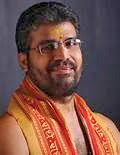The Process of Yoga : 2.7 - Swami Krishnananda.
========================================================================
========================================================================
Saturday, June 18, 2022. 06:00.
Chapter 2: The Structure of the Universe-7.
=======================================================================
Not only that, the consciousness projects itself even beyond our physical body in loves and hatreds. In loves and hatreds, in likes and dislikes, the consciousness projects itself beyond the body and catches objects outside. Then it is that we are affected by the world outside. When a loved object is taken away by bereavement, we get a shock because the consciousness gets a shock. It was temporarily tethered on the object due to affection and the object has been severed by an act of Providence, and then there is a temporary death of the self of consciousness itself, as it were. So we get a shock due to the death of relatives, and so on. When relatives die, why do we get a shock? Somebody is dying; why do we get pained? Why do we feel affected when somebody else dies? It is because that person is connected in our consciousness, and so it is like a tree feeling it has lost part of itself when a branch is cut off. Just as the vitality or the sap of the trunk of a tree manifests itself and flows through every branch and every tendril, every flower, fruit and leaf of the tree, in the tree of samsara the principle of consciousness seems to manifest itself through the trunk of the percipient and then project itself forward through the branches of objects which are liked and not liked. Raga-dvesha is a ramification of consciousness through the object world.
All this is an inferential proof of the fact that the purusha element, or the principle of consciousness, is not limited to the body. It is capable of containing the whole world within itself; and by a peculiar contact that it has established between itself and the world of objects outside, it has got involved in samsara. The samkhya gives us an analogy. Just as a crystal which has no colour can appear to have a colour of redness, etc., when a red flower is brought near it, the consciousness appears to have form when form is brought near it. A crystal has no colour. We cannot even see it if it is simply hung in space. But it assumes a colour when a coloured object is brought near it. The whole of the crystal has assumed a redness as if it is charged with redness, as if redness has entered it to its very central substance when the red object is brought close to it, though the colour has not really entered it, and cannot enter it. It always remains outside. It belongs to another object altogether, such as a red flower. So also the character of objects – lovability, beauty, desirability, etc. – cannot belong to consciousness. The consciousness cannot be limited, and yet it appears to be limited on account of its assumption of the character of objects outside due to proximity. As the colour of a flower can be reflected in a crystal, the character of objects can be reflected in our consciousness.
So instead of being merely witnesses of a world of objects, we have become part of the world, just as the crystal can be said to have become part of the colour of the flower. Then we regard ourselves as samsarins, caught in samsara and misery. “I am nobody. I am a poor person. I am grieved to the core of life.” Just as the crystal can assume the character of the object brought near it, we have assumed the character of the world of samsara. Diversity and objectivity are the characteristics of prakriti, or the object; and consciousness, which is like a crystal assuming the character and the colour of the object, regards itself as diversified. So we have many people and many objects in the world, each apparently unconnected with the other, each suffering due to limitation and change due to the process of evolution. Birth and death are the immediate outcome of this apparent separation of consciousness. It is apparent, not real – just as the colour of the crystal is apparent and does not really change the crystal. When the object is taken away from the crystal, the crystal stands pure as it was.
So also the principle objectivity has to be isolated from consciousness. This is called kaivalya or moksha. Kaivalya means kevalata. Kevala means oneness, alone, aloneness. When we stand alone as purusha, as consciousness, independent of association with objects or prakriti, we are said to have attained kaivalya. This is also called moksha. It is called moksha because it is freedom. Moksha means liberation, mukti, complete dissociation from all factors causing bondage. When the purusha isolates itself, separates itself from contact with prakriti, it is supposed to attain kaivalya moksha. We stand in our independent status. We are no more a slave to the enchantment of prakriti.
To attain this kaivalya, or moksha, we have to separate the principle of externality from us. The object is nothing but the element of externality; it is not something substantial. This we will know by a further analysis that we have to carry on in coming days. The principle of externality is what we called the object. It is not substantiality. It is merely externality, something introduced into the true substance of things due to a false association of consciousness with what is not itself. So again we have the difference between the Self and the not-Self. The Self is the principle of consciousness, and the not-Self is the principle of objectivity or externality. These two principles have been erroneously brought into a juxtaposition, and the world of samsara has been created.
To be continued ...
=========================================================================






Comments